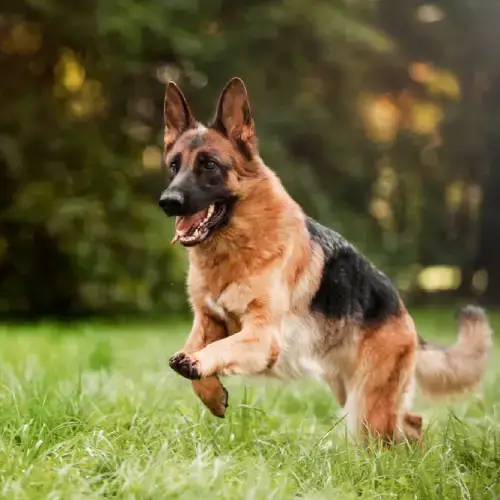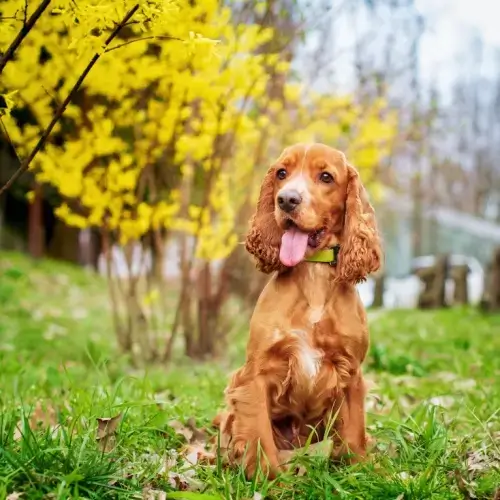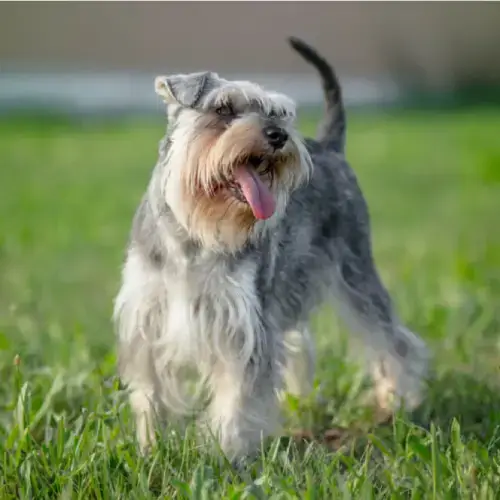Home / Compare Pet Insurance / Dog breeds and pet insur…

Key takeaways
- Some dog breeds are more likely to develop certain health conditions than others.
- If your dog’s breed is more likely to develop certain medical conditions, it’s a good idea to cover them with a pet insurance policy as early as possible before they show signs or symptoms.
- Some dog breeds can be more expensive to insure than others, particularly if they’re a ‘designer’ breed or more susceptible to certain medical issues.
Most popular dog breeds in Australia
Some people pick certain dog breeds for their easy-going temperament (like Labradors) or because they tend to have fewer health issues throughout their lives, while others may opt for non-shedding dog breeds like poodle mixes.
Researching different breeds may help you decide which furry friend may be most suitable for you and your lifestyle. Our guide to the most popular dog breeds in Australia (based on national pet registration statistics1) covers what you need to know about each breed, including their temperaments and any health problems that could potentially impact the cost of your pet insurance.
1. Labrador Retriever
 As Australia’s favourite dog breed, the Labrador is easily recognisable with its strong build, short fur coat and distinctive colours.2 Labradors are even-tempered and active dogs that make for devoted family pets. Because of their intelligence and kind, loyal nature, they’re well suited to working as guide and assistance dogs, as well as sniffer and tracking dogs.
As Australia’s favourite dog breed, the Labrador is easily recognisable with its strong build, short fur coat and distinctive colours.2 Labradors are even-tempered and active dogs that make for devoted family pets. Because of their intelligence and kind, loyal nature, they’re well suited to working as guide and assistance dogs, as well as sniffer and tracking dogs.
Labradors are a healthy dog breed but aren’t immune to various health problems. The main issues Labradors generally suffer from include hip and elbow dysplasia, as well as eye issues. They also tend to be rather greedy with food, so obesity comes rather easily to a Labrador!
2. Staffordshire Bull Terrier
 Affectionately known as a Staffy, the Staffordshire Bull Terrier is a short-coated, muscular and active dog.3 Despite their muscular appearance and bold, fearless temperament, Staffies are intelligent, affectionate and reliable companions, and are often used as therapy dogs.
Affectionately known as a Staffy, the Staffordshire Bull Terrier is a short-coated, muscular and active dog.3 Despite their muscular appearance and bold, fearless temperament, Staffies are intelligent, affectionate and reliable companions, and are often used as therapy dogs.
There are only a few health problems that Staffies are prone to, one of which is skin conditions.
3. Golden Retriever
 With their gentle temperament and kindly eyes, it’s no wonder Golden Retrievers are one of the most popular breeds in Australia. They’re strong but very affectionate and gentle, plus they love being around their family.4
With their gentle temperament and kindly eyes, it’s no wonder Golden Retrievers are one of the most popular breeds in Australia. They’re strong but very affectionate and gentle, plus they love being around their family.4
Retrievers are also highly intelligent and have been used as guide and therapy dogs. While they’re a fairly healthy breed of dog, they have been known to experience hip and elbow dysplasia, as well as eye problems like hereditary cataracts.
4. German Shepherd
 German Shepherds are exceptionally intelligent, devoted and attentive, and love attention from their human friends.5 This mix of traits means they make excellent family pets and work well as service, guard, protection and police dogs.6
German Shepherds are exceptionally intelligent, devoted and attentive, and love attention from their human friends.5 This mix of traits means they make excellent family pets and work well as service, guard, protection and police dogs.6
German Shepherds can experience hip and elbow dysplasia, as well as myelopathy and bloat.
5. Border Collie
 Border Collies are perhaps best known as working sheepdogs, but they also make for wonderful, devoted family pets.7 Their fluffy coats are commonly black and white, but you can also get a variety of red, mottled blue, gold, sable and brown-coloured Collies.
Border Collies are perhaps best known as working sheepdogs, but they also make for wonderful, devoted family pets.7 Their fluffy coats are commonly black and white, but you can also get a variety of red, mottled blue, gold, sable and brown-coloured Collies.
Border Collies are generally hardy and healthy dogs, but they can experience hip dysplasia, renal atrophy, epilepsy and deafness.
6. French Bulldog
 The French Bulldog – known as the Frenchie – is one of the small dog breeds, with a solid build, smooth coat and an affectionate and playful nature.8
The French Bulldog – known as the Frenchie – is one of the small dog breeds, with a solid build, smooth coat and an affectionate and playful nature.8
Frenchies tend to be loving and sweet, and can get along with just about anyone and any animal. However, they can experience some health problems. The main ones you’ll find among this breed include back weakness and breathing problems.
7. Cavalier King Charles Spaniel
 The Cavalier King Charles Spaniel has a long and rich history. They descend from the toy spaniels of the 16th and 17th centuries and are so named because of King Charles II’s great love of this friendly, easily trained small dog breed.9
The Cavalier King Charles Spaniel has a long and rich history. They descend from the toy spaniels of the 16th and 17th centuries and are so named because of King Charles II’s great love of this friendly, easily trained small dog breed.9
They have long, silky coats which come in a range of colours including a mix of black, tan, ruby, red and white. However, Cavaliers are prone to several health problems, including mitral valve disease and syringomyelia.
8. Rottweiler
 Rottweilers, or Rotties, are among the oldest dog breeds in the world, dating back to Roman times when they were used to drive cattle.10 Rotties can be medium to large-sized dogs and are distinguished by their black coat with tan markings.
Rottweilers, or Rotties, are among the oldest dog breeds in the world, dating back to Roman times when they were used to drive cattle.10 Rotties can be medium to large-sized dogs and are distinguished by their black coat with tan markings.
Rotties are a strong, intelligent and loyal breed. They can be susceptible to hip problems and eye diseases.
9. Cocker Spaniel
 Originally bred as skilful hunting dogs, Cocker Spaniels are today known for their loving and loyal nature, making for a dedicated and affectionate family companion.11 Their silky coats can be black, red or liver, and they need regular combing to ensure their fur stays healthy and shiny.12
Originally bred as skilful hunting dogs, Cocker Spaniels are today known for their loving and loyal nature, making for a dedicated and affectionate family companion.11 Their silky coats can be black, red or liver, and they need regular combing to ensure their fur stays healthy and shiny.12
Despite being a generally sturdy and healthy breed, Cocker Spaniels can experience eye problems and hip dysplasia as they age.11
10. Miniature Schnauzer
 There are three types of Schnauzers (miniature, standard and giant), each of which looks the same but just in different sizes.13 You can quickly identify a Schnauzer for their beards and eyebrows, giving the breed that mischievous expression they’re famous for.
There are three types of Schnauzers (miniature, standard and giant), each of which looks the same but just in different sizes.13 You can quickly identify a Schnauzer for their beards and eyebrows, giving the breed that mischievous expression they’re famous for.
Despite being a small dog breed, mini Schnauzers are quite sturdy and robust, with a square body shape. They’re intelligent with an instinct to guard, as they were originally bred as guard dogs, but are now mainly companion dogs. Only a few conditions like cardio myopathy are known to occur in the breed.
More information about dog breeds
What are the smartest dog breeds?
According to the American Kennel Club, some of the smartest dog breeds include:14
- Border Collie
- Poodle
- German Shepherd
- Golden Retriever
- Doberman
- Shetland Sheepdog
- Labrador Retriever
- Papillon
- Rottweiler
- Australian Cattle Dog.
Which dog breeds are hypoallergenic?
All dog breeds produce allergens (like dander, saliva and urine proteins) to some degree, so there’s no one breed that’s completely hypoallergenic.15 However, some dogs are better for allergies than others, including:
- Poodles
- Bichon Frises
- Yorkshire Terriers
- Malteses
- Portuguese Water Dogs
- Shih Tzus
- Schnauzers
- Cairn Terriers
- Havanese
- Chinese Crested dogs.
Which dog breeds bark the least?
Dogs bark for many reasons (since it’s their way of communicating with us), but some breeds can bark less than others.16 This can be due to the breed’s origins (having been developed to be quiet), but you may also find that individual dogs – regardless of breed – can be trained or raised to bark less.
Some ‘quiet’ dog breeds include:
- Afghan Hound
- Greyhound
- Basenji
- Chow Chow
- Collie
- Newfoundland
- Akita
- Shiba Inu
- Whippet
- Saint Bernard.
What dog breeds are banned in Australia?
Commonwealth customs legislation prohibits the importation of several specific dog breeds, including:17
- American pit bull terrier
- Dogo Argentino
- Fila Brasileiro
- Japanese tosa
- Perro de Presa Canario (or Presa Canario).
States and territories may have different legislation on the ownership of these restricted breeds.
Should I insure my dog?
Getting pet insurance for your beloved dog is a great way to help manage the potential costs if your dog has an accident or illness. If something were to go wrong, pet insurance can help cover some of the cost of vet bills, allowing you to focus on getting your furry friend back to health.
Some types of pet insurance may also come in handy if your dog is a breed prone to health problems. However, it’s a good idea to insure your pet early in their life or before they show symptoms of these problems, as claims relating to pre-existing conditions are usually considered exclusions in pet insurance policies. Check your Product Disclosure Statement (PDS) for full details.
Meet our pet insurance expert, Adrian Taylor
As a General Insurance expert with over 13 years’ experience in financial services, Adrian Taylor knows that dogs and cats get themselves into all sorts of mischief. One part of Adrian’s work is to help empower consumers to understand how pet insurance can help save them from exorbitant vet bills when their pet gets injured or falls ill.
Want to learn more about pet insurance?
1 Dogs Australia – National Animal Registration Analysis (2018-2023). Data obtained by totalling the number of registrations for each breed over 2018 to 2023 to determine the top 10 breeds. Accessed June 2024.
2 Dogs Australia – Labrador Retriever. Accessed June 2024.
3 Dogs Australia – Staffordshire Bull Terrier. Accessed June 2024.
4 Dogs Australia – Golden Retriever. Accessed June 2024.
5 Dogs Australia – German Shepherd Dog. Accessed June 2024.
6 Purina Australia – German Shepherd. Accessed June 2024.
7 Purina Australia – Border Collie. Accessed June 2024.
8 Dogs Australia – French Bulldog. Accessed June 2024.
9 Dogs Australia – Cavalier King Charles Spaniel. Accessed June 2024.
10 Purina Australia – Rottweiler. Accessed June 2024.
11 Dogs Australia – Cocker Spaniel. Accessed June 2024.
12 Purina Australia – English Cocker Spaniel. Accessed July 2024.
13 Dogs Australia – Schnauzer (Miniature). Accessed July 2024.
14 American Kennel Club – ‘Study Measuring Canine Intelligence Ranks Breeds as the Smartest’. Written by Elaine Waldorf Gewirtz, March 2024. Accessed July 2024.
15 Purina Australia – Hypoallergenic dog breeds. Accessed July 2024.
16 The Spruce Pets – ‘25 Quiet Dog Breeds That Bark Less’. Written by Jenna Stregowski, June 2024. Accessed July 2024.
17 AustLII – Customs (Prohibited Imports) Regulations 1956 – Schedule 1. Accessed July 2024.



